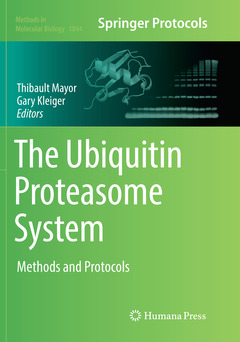Description
The Ubiquitin Proteasome System, 1st ed. 2018
Methods and Protocols
Methods in Molecular Biology Series, Vol. 1844
Coordinators: Mayor Thibault, Kleiger Gary
Language: English
Subject for The Ubiquitin Proteasome System:
Keywords
ubiquitination; E2 enzymes; poly-ubiquitin chains; flow cytometry; Cul4
413 p. · 17.8x25.4 cm · Paperback
Support: Print on demand
Description
/li>Contents
/li>Comment
/li>
?This volume explores numerous techniques used to study the ubiquitin proteasome system. The chapters in this book are organized into five parts and cover topics such as determining the mechanisms of action for E2s, E3s, and DUB enzymes; the latest advances to study the formation of poly-ubiquitin chains as well as their linkage types; the binding partners of proteins in the UPS; methods for structure determination by x-ray crystallography, cryo electron microscopy and SAXS; screening assays to select for degrons or modulators of E3s and DUBs; proteomics approaches in the ubiquitin field and methods to study 26S proteasome function. Written in the highly successful Methods in Molecular Biology series format, chapters include introductions to their respective topics, lists of the necessary materials and reagents, step-by-step, readily reproducible laboratory protocols, and tips on troubleshooting and avoiding known pitfalls.?
Thorough and authoritative, The Ubiquitin Proteasome System: Methods and Protocols is a valuable resource for both experienced and novice scientists who are interested in expanding their knowledge in this field.
Preface…
Table of Contents…
Contributors…
Part I Methods to Uncover the Mechanisms of Action for Enzymes that Assemble or Disassemble Poly-Ubiquitin Chains
1. Characterization of RING-Between-RING E3 Ubiquitin Transfer Mechanisms Katherine H. Reiter and Rachel E. Klevit
2. Single Turnover RING/U-Box E3-Mediated Lysine Discharge Assays
Lori Buetow, Mads Gabrielsen, and Danny T. Huang
3. Methods for NAD-Dependent Ubiquitination Catalyzed by Legionella pneumophila Effector Proteins
Jiazhang Qiu and Zhao-Qing Luo
4. Using In Vitro Ubiquitylation Assays to Estimate the Affinities of Ubiquitin-Conjugating Enzymes for their Ubiquitin Ligase Partners
Spencer Hill, Connor Hill, and Gary Kleiger
5. Competition Assay for Measuring Deubiquitinating Enzyme Substrate Affinity
Michael T. Morgan and Cynthia Wolberger
Part II Tools to Study Ubiquitylation
6. Enzymatic Assembly of Ubiquitin Chains
Martin A. Michel, David Komander, and Paul R. Elliott
7. Ubiquitin-Activated Interaction Traps (UBAITs): Tools for Capturing Protein-Protein Interactions
Hazel F. O’Connor, Caleb D. Swaim, Larissa A. Canadeo, and Jon M. Huibregtse
8. Generating Intracellular Modulators of E3 Ligases and Deubiquitinases from Phage-Displayed Ubiquitin Variant Libraries
Wei Zhang and Sachdev S. Sidhu
9. Integrated Proteogenomic Approach for Identifying Degradation Motifs in Eukaryotic Cells
Yifat Geffen, Alon Appleboim, Richard G. Gardner, and Tommer Ravid
10. A Method to Monitor Protein Turnover by Flow Cytometry and to Screen for Factors that Control Degradation by Fluorescence-Activated Cell Sorting
Sophie A. Comyn and Thibault Mayor
11. E. coli Based Selection and Expression Systems for Discovery, Characterization, and Purification of Ubiquitylated Proteins
Olga Levin-Kravets, Tal Keren-Kaplan, Ilan Attali, Itai Sharon, Neta Tanner, Dar Shapira, Ritu Rathi, Avinash Persaud, Noa Shohat, Anna Shusterman, and Gali Prag
Part III Structural Approaches as Applied to Enzymes that Participate in the Ubiquitin Proteasome System
12. Strategies to Trap Enzyme-Substrate Complexes that Mimic Michaelis Intermediates during E3-Mediated Ubiquitin-Like Protein Ligation
Frederick C. Streich Jr. and Christopher D. Lima
13. Small-Angle X-Ray Scattering for the Study of Proteins in the Ubiquitin Pathway
Jean-François Trempe and Kalle Gehring
14. Methods for Preparing Cryo-EM Grids of Large Macromolecular Complexes
Leifu Chang and David Barford
Part IV Methods to Study 26S Proteasome Function
15. Recombinant Expression, Unnatural Amino-Acid Incorporation, and Site-Specific Labeling of 26S Proteasomal Subcomplexes
Jared A. M. Bard and Andreas Martin
16. Native Gel Approaches in Studying Proteasome Assembly and Chaperones
Jeroen Roelofs, Anjana Suppahia, Kenrick A. Waite, and Soyeon Park
17. Measuring the Overall Rate of Protein Breakdown in Cells and the Contributions of the Ubiquitin-Proteasome and Autophagy-Lysosomal Pathways
Zhe Sha, Jinghui Zhao, and Alfred L. Goldberg
18. Methods to Rapidly Prepare Mammalian 26S Proteasomes for Biochemical Analysis
Chueh-Ling Kuo, Galen A. Collins, and Alfred L. Goldberg
19. Measurement of the Multiple Activities of 26S Proteasomes
Hyoung Tae Kim, Galen A. Collins, and Alfred L. Goldberg
20. Exploring the Regulation of Proteasome Function by Subunit Phosphorylation
Jordan J.S. VerPlank and Alfred L. Goldberg
21. Scalable In Vitro Proteasome Activity Assay
Amit Kumar Singh Gautam, Kirby Martinez-Fonts, and Andreas Matouschek
Part V Proteomic Methods to Study the Ubiquitin Proteasome System
22. Exploring the Rampant Expansion of Ubiquitin Proteomics
Amalia Rose and Thibault Mayor
23. Ubiquitin diGLY Proteomics as an Approach to Identify and Quantify the Ubiquitin-Modified Proteome
Amit Fulzele and Eric J. Bennett24. Interpreting the Language of Polyubiquitin with Linkage-Specific Antibodies and Mass Spectrometry
Marissa L. Matsumoto, Erick R. Castellanos, Yi Jimmy Zeng, and Donald S. Kirkpatrick
25. Dissecting Dynamic and Heterogeneous Proteasome Complexes Using In Vivo Cross-Linking Assisted Affinity Purification and Mass Spectrometry
Xiaorong Wang and Lan Huang
Includes cutting-edge methods and protocols
Provides step-by-step detail essential for reproducible results
Contains key notes and implementation advice from the experts




